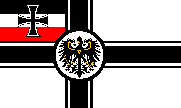
GROßE KREUZER
The Shell Magnet - SMS Seydlitz

Though outwardly similar to the Moltke-class, SMS Seydlitz was built with a longer but slimmer hull than SMS Moltke, with greater compartmentation and armor - her belt armor was on par with contemporary battleships. A raised forecastle made her a drier boat than her predecesors, but like them she mounted the tried and true 280mm (11") gun in 50 caliber. By this time her British adversaries were mounting 13.5"/45-cal guns, leaving SMS Seydlitz undergunned for her size. At the Battle of Dogger Bank she took a pair of shells aft that detonated near the aft two turrets, putting them out of action and killing their crews. Only with prompt damage control was a catastrophic explosion averted. In return SMS Seydlitz damaged HMS Lion so severely that she had to be towed home. But the lesson was taken to heart by the entire German Navy and improved ammunition handling procedures instituted to ensure such a hit could not threaten an entire vessel. At Jutland SMS Seydlitz was in the thick of it again, credited (with SMS Derfflinger) with sinking HMS Queen Mary. And when Admiral Scheer ordered the "Death Charge" by the battlecruisers to allow his main battlefleet to escape SMS Seydlitz was right there with the rest of the Scouting Squadron - even though all five main gun turrets were out of action. With hits from 21 shells 12" or larger and one torpedo, she limped home with more than 5,300 TONS of water sloshing in her hull, to the extent her bow had less than 2.5m (8 ft) of freeboard foreward when she pulled into port.
After finishing her design the German navy finally got around to building their battlecruisers in quantity instead of one's and two's while upgrading to the 305mm (12")/50-cal gun, unfortunately by the time the first of the Derfflinger-class had been commissioned, the war had begun.
PHOTOS
Plans and Construction
 Line Drawing - Top and Side Views (Koop)
Line Drawing - Top and Side Views (Koop)
 Line Drawing - Side View (Koop)
Line Drawing - Side View (Koop)
 Line Drawing - Top View (Koop)
Line Drawing - Top View (Koop)
 Line Drawing - Side View - 1918 (Greger)
Line Drawing - Side View - 1918 (Greger)
 Line Drawing - Side View - 1918 (Gröner)
Line Drawing - Side View - 1918 (Gröner)
 Armor Plan
Armor Plan
Active Duty
 Starboard Bow View while in drydock (U.S. National Archives)
Starboard Bow View while in drydock (U.S. National Archives)
 Starboard Bow Aspect (U.S. National Archives)
Starboard Bow Aspect (U.S. National Archives)
 Starboard Bow Aspect - 1913
Starboard Bow Aspect - 1913
 Starboard Bow Aspect
Starboard Bow Aspect
 "BRUNO" Turret and 150mm secondaries - Starboard Amidships (U.S. National Archives)
"BRUNO" Turret and 150mm secondaries - Starboard Amidships (U.S. National Archives)
 Starboard Aspect
Starboard Aspect
 Starboard Quarter Aspect - 1917
Starboard Quarter Aspect - 1917
 Starboard Quarter Aspect - From Above
Starboard Quarter Aspect - From Above
 View from the Quarterdeck
View from the Quarterdeck
 Port Bow Aspect
Port Bow Aspect
 Port Bow Aspect (U.S. National Archives)
Port Bow Aspect (U.S. National Archives)
The Battle of Jutland (aka the Battle of Skagerrak)
 Seydlitz steaming home after Jutland
Seydlitz steaming home after Jutland
 Starboard Bow showing Jutland Damage
Starboard Bow showing Jutland Damage
 Starboard Quarter showing Jutland Damage
Starboard Quarter showing Jutland Damage
 Port Quarter showing Jutland Damage
Port Quarter showing Jutland Damage
 Port Quarterdeck showing Jutland Damage
Port Quarterdeck showing Jutland Damage
 Port forecastle showing Jutland Damage
Port forecastle showing Jutland Damage
 Torpedo hit on port bow
Torpedo hit on port bow
The Final Act - Scapa Flow
 Port Bow Aspect - Steaming in to Surrender - 21 November 1918 (U.S. National Archives)
Port Bow Aspect - Steaming in to Surrender - 21 November 1918 (U.S. National Archives)
 Port Quarter Aspect - Steaming in to Surrender - 21 November 1918
Port Quarter Aspect - Steaming in to Surrender - 21 November 1918
 Port Quarter Aspect - Steaming in to Surrender - 21 November 1918
Port Quarter Aspect - Steaming in to Surrender - 21 November 1918
 Sunk at Scapa Flow - Port Side up
Sunk at Scapa Flow - Port Side up
SPECIFICATIONS
Project Name: Heavy Cruiser J
Builder: Blohm & Voss, Hamburg
Laid Down: February 4, 1911
Launched: March 30, 1912
Commissioned: May 11, 1913
Sunk: June 21, 1919 (Scuttled at Jutland)
Scrapped: Raised November, 1928 - Scrapped 1930
Displacement: 24,988 tonnes (designed) / 28,550 tonnes (maximum)
Dimensions (meters): 200.6 (overall) x 28.5 x 9.29
Dimensions (feet): 661.98 (overall) x 94.05 x 30.66
# of Shafts: 4
# of Propeller Blades: 3 (3.88m diameter)
# of Rudders: 2 (tandem - one ahead of the other)
Max Speed/Range: 26.5 kts / 4,200 nm at 14 kts
Main Battery: Ten 280mm (11")/50 caliber - 5 twin turrets
Secondary Battery: Twelve 150mm (5.9")/45 caliber - 12 casement mounts (Goeben only had 10 after 1915)
AA Battery: Twelve 88mm (3.5")/45 caliber - single mounts
Torpedo Tubes: Four 50cm tubes (all underwater - one bow, one stern [portside], one mounted on each side just forward of "Anton" turret)
Complement: 43 officers and 1,025 enlisted (as designed)
LINKS TO OTHER WEB-SITES
Warships of the World
Warships of the World German Naval Guns
Warships of the World Pre-World War II German Torpedoes
German Kriegsmarine Encyclopedia - Click on "Hochseeflotte"
Back to Großen Kreuzer.
Back to Home.
